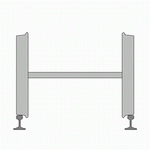
Photo from wikipedia
In this letter, we address the problem of circumnavigating a stationary target using a single vehicle. Unlike most existing results wherein the target is encircled in a two-dimensional plane, we… Click to show full abstract
In this letter, we address the problem of circumnavigating a stationary target using a single vehicle. Unlike most existing results wherein the target is encircled in a two-dimensional plane, we focus on devising a guidance strategy that enables a vehicle to encircle a target in a three-dimensional space using the relative information between the vehicle and the target. In particular, we assume that the vehicle has lateral acceleration capabilities only and that the radial acceleration is unavailable, thereby making the proposed design favorable for a class of aerial vehicles (e.g., aircraft and fixed-wing UAVs, which cannot hover and have to maneuver constantly). Therefore, the vehicle’s steering controls are its lateral acceleration components in the pitch and yaw channels. In addition, we also consider nonlinear, coupled three-dimensional engagement kinematics between the vehicle and the target to preserve the inherent coupling between various channels and to achieve satisfactory control precision even if the channels are strongly coupled. Furthermore, we minimize a relevant weighted cost function to obtain the lateral acceleration components in the pitch and the yaw channels. We finally demonstrate the efficacy of our design via simulations.
Journal Title: IEEE Control Systems Letters
Year Published: 2023
Link to full text (if available)
Share on Social Media: Sign Up to like & get
recommendations!